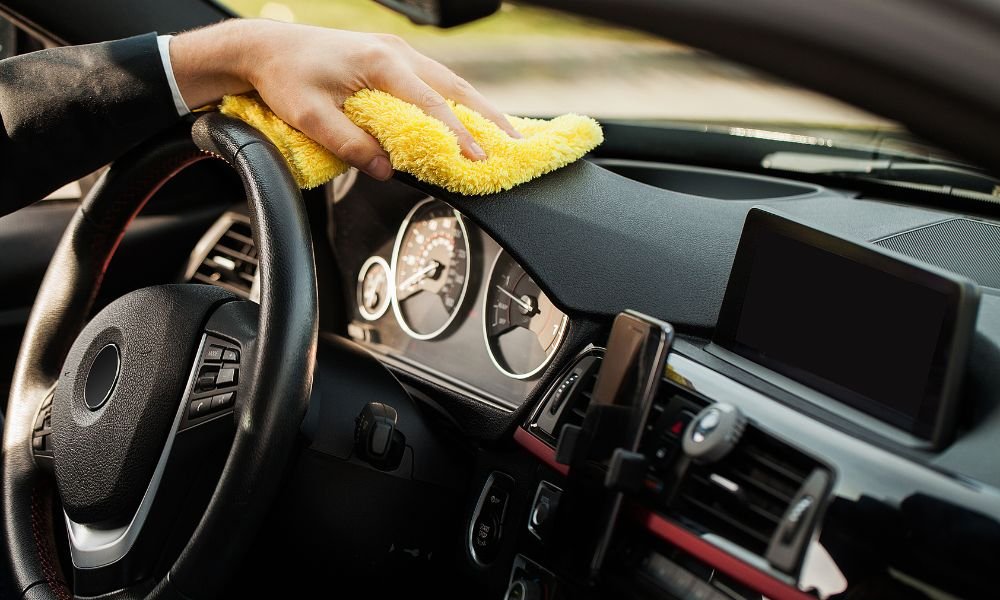Modern vehicle interiors combine sophisticated materials with complex electronics, creating environments that require thoughtful protection strategies to maintain their appearance and functionality. Understanding the science behind interior degradation helps car owners implement effective preservation techniques that extend the life and beauty of their vehicle’s cabin. Let’s explore professional-grade approaches to interior protection that go beyond basic cleaning.
Understanding Interior Degradation Factors
Your vehicle’s interior faces multiple threats daily, with ultraviolet radiation leading the charge in material breakdown. UV rays penetrate automotive glass and gradually break down chemical bonds in interior materials, causing fading, cracking, and deterioration of surfaces. Heat amplifies this effect, creating a greenhouse environment that accelerates aging processes. Understanding these fundamental degradation mechanisms helps develop effective protection strategies.
The Science of UV Protection
Professional-grade UV protection involves multiple layers of defense. Quality window tinting provides the first barrier, blocking up to 99% of harmful UV rays while reducing interior temperatures. Modern ceramic tints offer superior heat rejection compared to traditional metallic films, helping preserve electronics and preventing material warping. Even in regions where tinting regulations limit darkness levels, clear UV-protective films can provide significant benefits.
Beyond tinting, applying UV-protective coatings to interior surfaces creates an additional defense layer. Professional-grade protectants contain UV absorbers and stabilizers that help prevent color fading and material degradation. These treatments work particularly well on dashboard surfaces and leather components most exposed to sunlight.
Leather Care and Protection
Leather requires specialized protection due to its natural properties and vulnerability to environmental factors. Professional leather care begins with understanding leather types – modern automotive leather typically features a protective coating that requires different care than traditional natural leather. Regular cleaning removes oils and contaminants that can break down these protective layers.
Applying appropriate leather conditioners helps maintain proper moisture levels, preventing cracking and premature aging. Look for products containing natural oils and UV inhibitors specifically formulated for automotive use. Pay particular attention to high-wear areas like seat bolsters and steering wheels, where regular contact can wear away protective coatings.
Fabric and Carpet Protection
Modern automotive fabrics benefit from advanced protection technologies that create invisible barriers against stains and wear. Professional-grade fabric protectants form molecular bonds with fibers, allowing them to repel liquids while maintaining breathability. These treatments prove particularly valuable for light-colored interiors or vehicles regularly exposed to challenging conditions.
Proper application technique matters significantly for fabric protection. Professional applicators use specialized equipment to ensure even coverage and proper penetration into fibers. Consider having protection reapplied annually or after deep cleaning to maintain optimal performance. Some newer products offer antimicrobial properties that help prevent odor-causing bacteria growth.
Electronic Component Protection
Modern vehicle interiors contain numerous electronic components requiring specific protection strategies. Touchscreens and display surfaces benefit from specialized protective films that maintain clarity while reducing fingerprints and glare. These films often include antimicrobial properties that help maintain hygiene in frequently touched areas.
Consider using protective covers for electronic interfaces when the vehicle sits unused for extended periods. UV exposure can affect display clarity and performance over time. Some professional-grade covers incorporate reflective materials that help reduce heat buildup around sensitive components.
Climate Control Strategies
Effective climate management significantly impacts interior longevity. Parking in shaded areas or using quality car covers helps reduce interior temperatures. Consider installing solar-powered ventilation fans for periods of extended parking. These simple devices can significantly reduce interior temperatures while removing moisture that could promote mold growth.
Regular maintenance of your vehicle’s air conditioning system helps maintain optimal interior conditions. Clean cabin air filters prevent contaminant accumulation on interior surfaces while maintaining proper humidity levels. Some professional-grade filters incorporate activated carbon elements that help remove odors and harmful gases.
Surface Protection Technologies
Advanced surface protection technologies offer long-term benefits for interior preservation. Ceramic coating technologies, originally developed for exterior paint protection, now include formulations specifically designed for interior surfaces. These coatings provide exceptional resistance to wear, UV damage, and contamination while maintaining original surface appearance and texture.
Professional application of these coatings requires careful surface preparation and controlled application conditions. While representing a significant initial investment, quality ceramic coatings can provide years of protection with proper maintenance. Consider having high-wear surfaces like door panels and center consoles treated first if budget constraints exist.
Maintenance Protocols for Longevity
Establishing regular maintenance protocols helps maximize the effectiveness of protection measures. Develop cleaning routines that address different interior materials appropriately. Use appropriate tools and products for each surface type, and maintain separate cleaning materials for different areas to prevent cross-contamination.
Document protection treatments and maintenance activities to ensure consistent care. Regular inspection helps identify potential issues before they become significant problems. Consider creating a maintenance calendar that includes both routine care and periodic professional treatments.
Professional Intervention Points
While many protection measures can be implemented by vehicle owners, certain treatments benefit from professional application. Complex electronics, specialized coatings, and some fabric protection treatments require specific equipment and expertise for optimal results. Building a relationship with qualified professionals helps ensure proper care while potentially identifying issues before they become serious problems.
Investment in quality interior protection typically proves cost-effective compared to replacing or repairing damaged components. Consider protection measures as preserving both vehicle value and daily comfort. Remember that prevention generally costs less than restoration, particularly with modern vehicle interiors’ complexity and replacement costs.














Add Comment